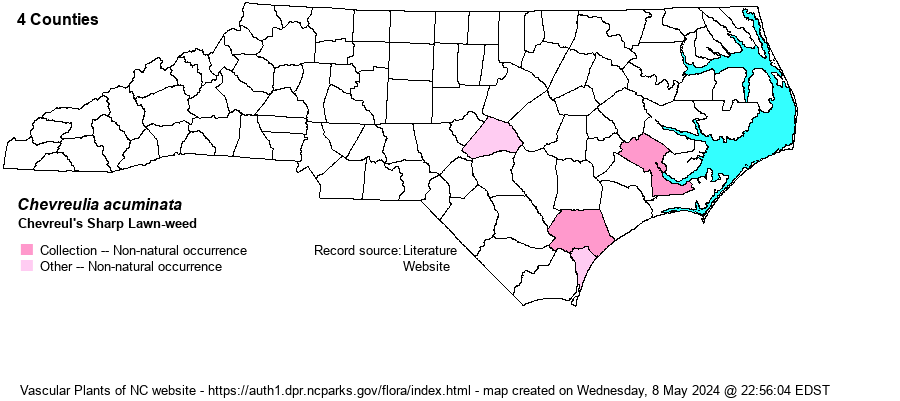| Author | Less. | |
| Distribution | This South American composite has recently (2010s and later) been discovered at a handful of sites in the Southeastern states, mostly in lawns. In NC, first reported only in 2023, in a lawn in Harnett County; photos and comments are on Facebook Carolina Flora. In addition, the iNaturalist website now has a photo accepted record for New Hanover County, in June 2023. The species was reported on Facebook also for Cabarrus County, but until photos or specimen are posted for review and acceptance, this county is not being added to the map below. A paper published in Castanea 88: 211-213 reports this alien from lawns in Craven and Pender counties in 2023 and 2021, respectively); specimens at NCSC. These records suggest that this species has become firmly established in the NC southeastern Coastal Plain, at least.
Native to South America. A recent addition to the U.S. flora, first noted in 2012 in AL. Keith Bradley says on Facebook "We've now got it essentially throughout SC, including Landrum just miles from Polk County, NC." | |
| Abundance | Probably very rare, but clearly increasing in the Southeast, and many new NC records are likely in the next few years as people become more familiar with this "lawn pest". | |
| Habitat | Mainly in lawns, at the present time. In AL, it has been found "in lawns, on roadsides, in cemeteries, and in vacant lots". | |
| Phenology | Fruits are being noted in June on NC lawns; thus, flowering is in spring or very early summer. | |
| Identification | This is a mat-like, almost moss-like, plant with very very short, grasslike leaves at and near the stem base, and a conspicuous "dandelion fluff-ball" fruit on a raised stalk up to 6" tall; however, flowers are imperceptible. From the Alabama Plant Atlas: "It is a perennial with procumbent creeping stems. Leaves are basal and low-cauline, opposite, sessile, oblong-lanceolate in outline, entire, with a prominent mucro tip. The leaves are downy pubescent on both surfaces though less so on the upper. Flowers are produced in heads. The heads are solitary and nearly sessile at flowering with leafless, pubescent peduncles that elongate as the fruit mature to 4-6 inches. The lanceolate phyllaries are in 2-3 slightly graduated series. The outer phyllaries are pubescent basally. The heads contain only disc flowers. The outer flowers are pistillate and the inner are bisexual. The corolla is tubular, greenish-white with purple tips. The fruit is an achene with a long pubescent beak supporting a crown of pappus composed of capillary bristles. — A. Diamond". The stem is white with very dense, very short, appressed hairs.
| |
| Taxonomic Comments | None.
| |
| Other Common Name(s) | Skyseed | |
| State Rank | SE | |
| Global Rank | GNR | |
| State Status | | |
| US Status | | |
| USACE-agcp | | |
| USACE-emp | | |

